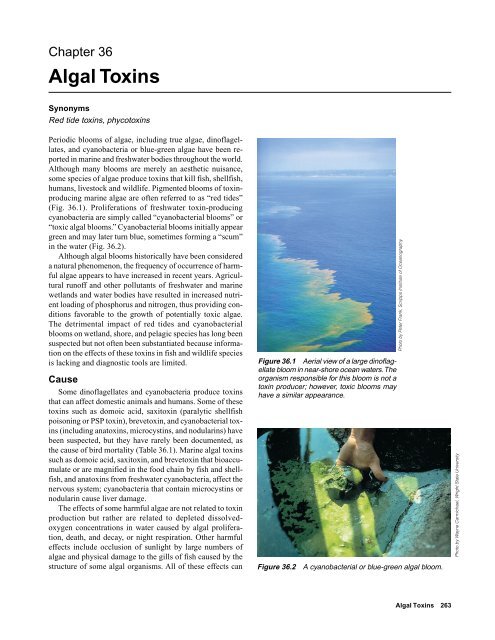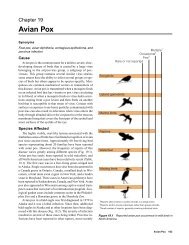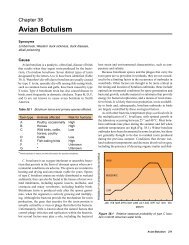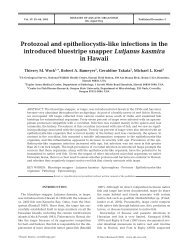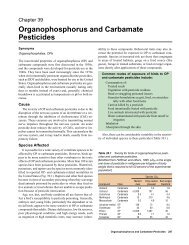Algal Toxins
Algal Toxins
Algal Toxins
Create successful ePaper yourself
Turn your PDF publications into a flip-book with our unique Google optimized e-Paper software.
Chapter 36<br />
<strong>Algal</strong> <strong>Toxins</strong><br />
Synonyms<br />
Red tide toxins, phycotoxins<br />
Periodic blooms of algae, including true algae, dinoflagellates,<br />
and cyanobacteria or blue-green algae have been reported<br />
in marine and freshwater bodies throughout the world.<br />
Although many blooms are merely an aesthetic nuisance,<br />
some species of algae produce toxins that kill fish, shellfish,<br />
humans, livestock and wildlife. Pigmented blooms of toxinproducing<br />
marine algae are often referred to as “red tides”<br />
(Fig. 36.1). Proliferations of freshwater toxin-producing<br />
cyanobacteria are simply called “cyanobacterial blooms” or<br />
“toxic algal blooms.” Cyanobacterial blooms initially appear<br />
green and may later turn blue, sometimes forming a “scum”<br />
in the water (Fig. 36.2).<br />
Although algal blooms historically have been considered<br />
a natural phenomenon, the frequency of occurrence of harmful<br />
algae appears to have increased in recent years. Agricultural<br />
runoff and other pollutants of freshwater and marine<br />
wetlands and water bodies have resulted in increased nutrient<br />
loading of phosphorus and nitrogen, thus providing conditions<br />
favorable to the growth of potentially toxic algae.<br />
The detrimental impact of red tides and cyanobacterial<br />
blooms on wetland, shore, and pelagic species has long been<br />
suspected but not often been substantiated because information<br />
on the effects of these toxins in fish and wildlife species<br />
is lacking and diagnostic tools are limited.<br />
Cause<br />
Some dinoflagellates and cyanobacteria produce toxins<br />
that can affect domestic animals and humans. Some of these<br />
toxins such as domoic acid, saxitoxin (paralytic shellfish<br />
poisoning or PSP toxin), brevetoxin, and cyanobacterial toxins<br />
(including anatoxins, microcystins, and nodularins) have<br />
been suspected, but they have rarely been documented, as<br />
the cause of bird mortality (Table 36.1). Marine algal toxins<br />
such as domoic acid, saxitoxin, and brevetoxin that bioaccumulate<br />
or are magnified in the food chain by fish and shellfish,<br />
and anatoxins from freshwater cyanobacteria, affect the<br />
nervous system; cyanobacteria that contain microcystins or<br />
nodularin cause liver damage.<br />
The effects of some harmful algae are not related to toxin<br />
production but rather are related to depleted dissolvedoxygen<br />
concentrations in water caused by algal proliferation,<br />
death, and decay, or night respiration. Other harmful<br />
effects include occlusion of sunlight by large numbers of<br />
algae and physical damage to the gills of fish caused by the<br />
structure of some algal organisms. All of these effects can<br />
Figure 36.1 Aerial view of a large dinoflagellate<br />
bloom in near-shore ocean waters. The<br />
organism responsible for this bloom is not a<br />
toxin producer; however, toxic blooms may<br />
have a similar appearance.<br />
Figure 36.2<br />
A cyanobacterial or blue-green algal bloom.<br />
Photo by Peter Frank, Scripps Institute of Oceanography<br />
Photo by Wayne Carmichael, Wright State University<br />
<strong>Algal</strong> <strong>Toxins</strong> 263
Table 36.1<br />
Documented instances of wild bird mortality caused by algal toxins.<br />
Migratory bird<br />
Route of<br />
Toxin <strong>Algal</strong> species Toxin type(s) species affected exposure<br />
Cyanobacterial Microcystis sp., Hepatotoxins Unidentified ducks, Oral<br />
Anabaena sp., (microcystins geese, and songbirds, (water)<br />
Aphanizomenon sp., and nodularin) Franklin’s gull, American<br />
Nodularia sp., Neurotoxins coot, mallard, American<br />
and (anatoxin-a and wigeon<br />
Oscillatoria sp. anatoxin-a(s))<br />
Domoic acid Pseudonitzschia sp. Neurotoxin Brown pelican, Oral<br />
(amnesic shellfish Brandt’s cormorant (food items)<br />
poisoning)<br />
Saxitoxin Alexandrium sp. Neurotoxin Shag, northern fulmar, Oral<br />
(paralytic great cormorant, (food items)<br />
shellfish<br />
herring gull, common<br />
poisoning)<br />
tern, common murre,<br />
Pacific loon, and sooty<br />
shearwater<br />
Brevetoxin Gymnodinium sp. Neurotoxin Lesser scaup Oral<br />
(food items)<br />
lead to mortality of aquatic invertebrates, aquatic plants, or<br />
fish and may produce an environment conducive to botulism.<br />
Other marine algal toxins (okadaic acid, neosaxitoxin,<br />
ciguatoxin, and Pfiesteria exotoxin) and cyanobacterial toxins<br />
(saxitoxin, neosaxitoxin, and cylindrospermopsin) have<br />
not yet been identified as causes of bird mortality events, but<br />
increased awareness and further research may establish a<br />
relationship.<br />
Species Affected<br />
Many bird and mammal species can be affected by algal<br />
toxins. Most reports of mortality in birds are of die-offs that<br />
occur in conjunction with a bloom. Sometimes algal toxins<br />
are found in potential food items; however, there have been<br />
very few instances in which the algal toxin has been isolated<br />
from the ingesta or tissues of affected birds. Domoic acid<br />
poisoning caused mortality in brown pelicans and Brandt’s<br />
cormorants on the central California coast. Brevetoxin has<br />
been suspected as the cause of mortality in lesser scaup, and<br />
saxitoxin has been strongly suspected as the cause of mortality<br />
in sea birds (common terns, shags, great cormorants,<br />
northern fulmars, herring gulls, common murres, Pacific<br />
loons, sooty shearwaters, and others). Cyanobacterial toxicosis<br />
has been suspected in mortalities of free-ranging ducks,<br />
geese, eared grebes, gulls, and songbirds.<br />
Distribution<br />
Many of the organisms responsible for red tides are widely<br />
distributed and, in recent years, the organisms seem to be<br />
markedly spreading. Natural events such as hurricanes can<br />
disperse organisms, and it is suspected that some organisms<br />
may be transported long distances in ship ballast waters. Another<br />
factor that may encourage algal proliferation in both<br />
marine and freshwater systems is increased nutrient loading.<br />
Certain algae occur more commonly in some areas than<br />
others and it is useful to know which ones are problems in<br />
specific locations. Good sources of information about algal<br />
blooms are the State public health department or the State<br />
division of marine resources or marine fisheries.<br />
264 Field Manual of Wildlife Diseases: Birds
Seasonality<br />
There have not been enough confirmed instances of wild<br />
bird mortality caused by red tides and cyanobacterial blooms<br />
to establish seasonal patterns of occurrence.<br />
Field Signs<br />
Field signs reported are variable and they depend on the<br />
toxin involved. Domoic acid poisoning of brown pelicans<br />
caused neurologic signs that included muscle tremors, a characteristic<br />
side-to-side head movement, pouch scratching,<br />
awkward flight, toe clenching, twisting of the head over the<br />
back, vomiting, and loss of the righting reflex just before<br />
death. Brandt’s cormorants that also were involved in this<br />
mortality event were easily approached and handled, but they<br />
did not exhibit the neurologic signs seen in the pelicans. Sea<br />
birds suspected of having been poisoned by saxitoxin exhibited<br />
paralysis and vomiting. Clinical signs observed in lesser<br />
scaup suspected of having been poisoned by brevetoxin included<br />
lethargy, weakness, reluctance or inability to fly, head<br />
droop, and excessive ocular, nasal, and oral discharge.<br />
White Pekin ducklings that were experimentally exposed<br />
to brevetoxins exhibited lethargy, loss of muscle coordination<br />
or ataxia, spastic head movements, head droop to one<br />
side, and leg extension to the rear during rest. Clinical signs<br />
in muscovy ducks dosed with anatoxin-a(s) included excessive<br />
salivation, regurgitation of algae, diarrhea, tremors, reduced<br />
responsiveness and activity, incoordination, difficulty<br />
breathing, excessive thirst, congestion in foot webs, wing<br />
and leg weakness, and recumbency and intermittent seizures<br />
prior to death.<br />
Gross Lesions<br />
No characteristic or diagnostic gross lesions have been<br />
described for most types of algal toxin poisonings of wild<br />
birds. Many of the toxins, particularly the neurotoxins, have<br />
a chemical effect that does not produce a grossly observable<br />
lesion. Birds that ingest toxic blooms of Microcystis may<br />
have notable lesions of necrosis or tissue death and hemorrhage<br />
in the liver. These lesions have been reported in domestic<br />
mammals and birds, including ducks, that died as a<br />
result of exposure to a toxic Microcystis algal bloom or that<br />
were experimentally dosed with microcystin.<br />
Diagnosis<br />
Definitive diagnosis of algal toxicosis is difficult. Circumstantial<br />
evidence, such as the occurrence of a marine red tide<br />
or freshwater cyanobacterial bloom in conjunction with a<br />
die-off, and supportive clinical and pathologic findings, such<br />
as a lack of evidence of the presence of other types of toxins<br />
or infectious disease, are often used to reach a presumptive<br />
diagnosis. Analysis of the upper gastrointestinal tract contents<br />
or tissues of affected birds for algal toxins is possible<br />
but the tests are not yet widely available. In addition, there<br />
are no established toxic thresholds for wildlife species. Even<br />
when levels of particular toxins can be measured it may be<br />
difficult to assess their significance. Recently developed<br />
methods permit detection of microcystins in animal tissues<br />
and gastrointestinal contents by using enzyme linked immunosorbent<br />
assay (ELISA) technologies. Also, it is now possible<br />
to detect saxitoxin in urine and blood samples from<br />
affected animals by using highly sensitive neuroreceptor assays.<br />
A sample of organisms from the bloom may be useful or<br />
necessary for diagnosis. Because of the ephemeral nature of<br />
blooms, collect algal samples during the die-off event as soon<br />
as possible after carcasses are found. Contact a diagnostic<br />
laboratory for advice on appropriate sample collection.<br />
A<br />
B<br />
Photos by JoAnn Burkholder, North Carolina State University<br />
Figure 36.3 (A and B) These fish were killed by Pfiesteria sp., an organism that has caused neurological problems, including<br />
prolonged amnesia, in people exposed by aerosols in a laboratory. This organism has only been fully described recently, and it<br />
has not been reported to cause mortality in birds; however, it may be encountered by biologists investigating concurrent bird and<br />
fish kills.<br />
<strong>Algal</strong> <strong>Toxins</strong> 265
Control<br />
Because it is difficult to identify algal toxins as the cause<br />
of wildlife mortalities, there has been little opportunity to<br />
consider control measures. Currently, there is much interest<br />
in algal toxins and their threat to human water and food supplies.<br />
Identification of the conditions that trigger harmful algal<br />
blooms may aid in developing strategies to prevent red tides<br />
or freshwater cyanobacterial blooms and associated wildlife<br />
mortality. Controlling nutrient loading through reduced fertilizer<br />
use, improved animal waste control, and improved<br />
sewage treatment may reduce the number, or likely locations,<br />
of toxic algal blooms. Careful monitoring and early detection<br />
of potentially toxic algal blooms could allow time to<br />
initiate actions to prevent or reduce bird mortality.<br />
Human Health Considerations<br />
Most red tide and toxic freshwater cyanobacteria are not<br />
harmful unless they are ingested. However, some organisms<br />
irritate the skin and others release toxic compounds into the<br />
water and, if aerosolized by wave action, these compounds<br />
may cause problems when people inhale them (Fig. 36.3).<br />
When investigating wildlife mortality that is occurring in conjunction<br />
with a known red tide or cyanobacterial bloom, contact<br />
the local public health department or a diagnostic laboratory<br />
for information on precautions you may need to take.<br />
As in the investigation of all wildlife mortality events, wear<br />
rubber or latex gloves when handling carcasses.<br />
Lynn H. Creekmore<br />
Supplementary Reading<br />
Anderson, D.A., 1994, Red tides: Scientific American, August,<br />
p. 62–68.<br />
_____, 1994, The toxins of cyanobacteria: Scientific American,<br />
January, p. 78–86.<br />
Forrester, D.J., Gaskin, J.M., White, F.H., Thompson, N.P., Quick,<br />
J.A., Jr., Henderson, G.E., Woodard, J.C., and Robertson,<br />
W.D., 1977, An epizootic of waterfowl associated with a red<br />
tide episode in Florida: Journal of Wildlife Diseases, v. 13,<br />
p. 160–167.<br />
Nisbet, I.C.T., 1983, Paralytic shellfish poisoning: Effects on<br />
breeding terns; Condor, v. 85, p. 338–345.<br />
Work, T.M., Barr, B., Beale, A. M., Quilliam, M.A., and Wright,<br />
J.L.C., 1993, Epidemiology of domoic acid poisoning in brown<br />
pelicans (Pelecanus occidentalis) and Brandt’s cormorants<br />
(Phalacrocorax penicillatus) in California: Journal of Zoo and<br />
Wildlife Medicine, v. 24, p. 54–62.<br />
266 Field Manual of Wildlife Diseases: Birds


